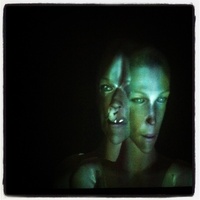
Kathy Cleland
Related Authors
Stephen Fernandez
University of Waterloo
Jason Kennedy
Auckland University of Technology
Rob Saunders
Leiden University
Petra Gemeinboeck
Swinburne University of Technology, Prahran
Louis-Philippe Demers
Nanyang Technological University
Georgie Roxby Smith
University of Melbourne
Gregory O'Hare
Trinity College Dublin
Alcides Peron
Universidade de São Paulo
Miran Bulut
Pompeu Fabra University
InterestsView All (8)










Uploads
Books by Kathy Cleland
Papers by Kathy Cleland
screen-based (virtual) and embodied (robotic) entities
in the mixed reality terrain of the gallery space. While
it would seem that physical three-dimensional objects
in a gallery space, especially self-moving objects such
as robots, have a distinct advantage in the reality
stakes over screen images, the author suggests that
there is no hard and fast distinction between how audiences
respond to robotic entities and to screen-based
virtual characters. It is the ability of an artwork to
respond to and ‘dialogue’ with its audience—to ‘look
back’ and ‘talk back’—that is the key factor in making
it an engaging and believable social partner. Artists discussed
include Mari Velonaki, Stelarc, Ruairi Glynn,
Karolina Sobecka and Golan Levin.
While the digital avatar represents some unique new opportunities for individuals to choose and control their prosthetic visual identities, this thesis demonstrates that the idea of the physical self being represented by a virtual image-body is not as new or as revolutionary as the hype surrounding avatars in digital environments might suggest. In fact, the idea of a virtual image-body has been around for a long time, manifested in the technological mediations or ‘body-images’ seen in mirrors, paintings, film and video. These mediated images of the self act as our proxies and stand-ins extending and reactivating the self in a variety of different environments and situations. With cumulative advances in imaging and media technologies, our mediated images have become increasingly malleable, responsive and interactive. More and more, as we interact with each other through images and screens, the mediated face-to-face encounter is coming to extend and augment—and even to replace—the physical face-to-face encounter.
The aim of this thesis is to explore the unique affordances of the digital avatar as well as to situate it within a broader media ecology of earlier technologically mediated ‘image avatars’ of the self including mirror images, photographs, film and video.
Through this investigation of our different image avatars, this thesis argues that the self is becoming a mixed and multiple reality, both physical and virtual. Through our image avatars, we experience ourselves as both self and other, physical and virtual, singular and multiple, dispersed through our various avatar identities as they migrate from the physical world to photographs, video, the internet, games consoles, personal computers and mobile phones.
screen-based (virtual) and embodied (robotic) entities
in the mixed reality terrain of the gallery space. While
it would seem that physical three-dimensional objects
in a gallery space, especially self-moving objects such
as robots, have a distinct advantage in the reality
stakes over screen images, the author suggests that
there is no hard and fast distinction between how audiences
respond to robotic entities and to screen-based
virtual characters. It is the ability of an artwork to
respond to and ‘dialogue’ with its audience—to ‘look
back’ and ‘talk back’—that is the key factor in making
it an engaging and believable social partner. Artists discussed
include Mari Velonaki, Stelarc, Ruairi Glynn,
Karolina Sobecka and Golan Levin.
While the digital avatar represents some unique new opportunities for individuals to choose and control their prosthetic visual identities, this thesis demonstrates that the idea of the physical self being represented by a virtual image-body is not as new or as revolutionary as the hype surrounding avatars in digital environments might suggest. In fact, the idea of a virtual image-body has been around for a long time, manifested in the technological mediations or ‘body-images’ seen in mirrors, paintings, film and video. These mediated images of the self act as our proxies and stand-ins extending and reactivating the self in a variety of different environments and situations. With cumulative advances in imaging and media technologies, our mediated images have become increasingly malleable, responsive and interactive. More and more, as we interact with each other through images and screens, the mediated face-to-face encounter is coming to extend and augment—and even to replace—the physical face-to-face encounter.
The aim of this thesis is to explore the unique affordances of the digital avatar as well as to situate it within a broader media ecology of earlier technologically mediated ‘image avatars’ of the self including mirror images, photographs, film and video.
Through this investigation of our different image avatars, this thesis argues that the self is becoming a mixed and multiple reality, both physical and virtual. Through our image avatars, we experience ourselves as both self and other, physical and virtual, singular and multiple, dispersed through our various avatar identities as they migrate from the physical world to photographs, video, the internet, games consoles, personal computers and mobile phones.